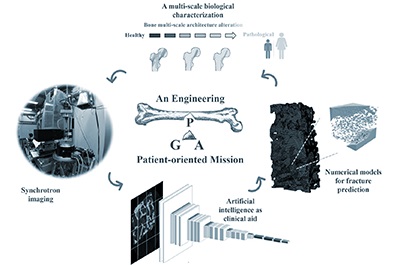
GAP originates from the active collaboration between national and international research centers, from the crossover of various and interpenetrating skills. The GAP (image-Guided computational and experimental Analysis of fractured Patients) project, has an ambitious goal: to obtain an early diagnosis of bone diseases and to assist clinicians in the therapeutic process. GAP started in 2020 to responds to the need of clinicians of Gruppo San Donato Foundation (Galeazzi Orthopaedic Institute, Milan) to limit the criticalities induced by bone fragility fractures, which are worryingly incrementing due to the increase in the average age of the population and the onset of bone diseases. Indeed, forecasts indicate an increase of these fractures in Italy of 22.4% by 2030. In addition to their dramatic incidence on the population, especially on women, a serious problem of economic and psychosocial nature emerges.
On the one hand, the increased hospitalization has an exponential impact on the health system, on the other hand, the loss of mobility and independence is an important cause of psychological decline on patient’s side. Currently, in the clinic, bone fragility fractures are recognized and treated with evident delay, when the prognosis may be severe or even catastrophic. The actual diagnostic imaging techniques, such as radiographs or Dual X-ray Absorptiometry, work with a resolution in the order of millimeters, inadequate to detect the onset of micro-fractures, which represent the origin of the damage phenomenon. Additionally, these techniques often suffer from clinician’s subjectivity. And so, GAP sees the light, shaped in the Department of Mechanics of the Politecnico di Milano, by the hands of Professor Vergani, coordinator of the project with decades of specific experience in fracture mechanics, and by the PhD student Federica Buccino, who combines the mechanical aspects with the biomedical field of the study.
In order to better describe the GAP action plan, it is crucial to provide answers to some questions:
What is GAP's innovative idea for alleviating the burden of fragility fractures?
In order to achieve early diagnosis of bone disease and reduce the socio-economic impact of fractures, action must be taken before the fracture requires massive clinical intervention. For this reason, GAP research focuses on bone micro-scale, characterized by elliptical micro-porosities (lacunae), whose role in damage mechanisms has not been elucidated yet. Visualizing the architecture of the lacunar network, investigating and simulating the onset of micro-damage and finally predicting its evolution at the multi-scale, are factors of great interest both from a biomechanical and a clinical perspective.
Which is GAP network?
In order to pursue its objectives, the synergy of competences is an aspect of primary importance: GAP collaborates with a national and international excellence network.
The project started from a collaboration with the Gruppo San Donato without economic exchange (in self-financing); later the other partners joined.
Bone mechanical and biological characterization at multiscale ? ELETTRA Synchrotron (prof. Tromba), EMPA (prof. Schwiedrzik), University of Strasbourg (prof. Carradò), University of Eindhoven (prof. Hofmann).
Numerical modeling of bone damage ? Trinity College Dublin (prof. Taylor), Dioscuri Centre in Topological Data Analysis (prof. Dlotko), ETH Zurich (prof. Müller), TU Delft (prof. Zadpoor, prof. Mirzaali)
From the research to the clinics: artificial intelligence for micro-damage detection ? NTNU (prof. Berto)
Clinical partners and social impact ? Istituto Ortopedico Galeazzi (prof. Banfi) and Cittadinanzattiva (dr. Nicoletti).
A sub-section of GAP research is performed in collaboration with Alta Scuola Politecnica, obtaining promising results. A group of five students developed a deep learning algorithm able to automatically detect bone lacunae, leading to immediate processing of synchrotron images.
What are GAP reached goals?
GAP project has achieved several encouraging results, which boost its development. Currently, thanks to the mechanical and electronic design and consequent realization of a micro-compression device, it has been possible to map the local mechanical characteristics of healthy and pathological femoral heads. This allows to determine the areas with the highest Young's modulus, where loads are transmitted from the pelvis to the femur. Moreover, the implemented methodology permit to evaluate the inter-patient variability, identifying borderline cases of subjects affected by local arthrosis or osteopenia. The mechanical characterization, combined with synchrotron imaging at 1.6 µm resolution at increasing applied displacement intervals, allow to estimate the interactions between micro-cracks and lacunae, identifying toughening phenomena such as ligament bridging. The high computational costs resulting from extremely high-resolution data leads to the implementation of convolutional neural networks for the automatic localization and detection of micro-cracks and lacunae. We observe that, in all the analyzed cases, micro- cracks do not originate from lacunae, that present a higher density and an elliptical shape in presence of osteoporosis.
What is the future of GAP?
Advanced synchrotron imaging techniques, together with local mechanical characterization, allow to understand how micro-damage develops within human bones. The obtained high-resolution images permit the implementation of validated computational models, able to predict the regions where there is a high risk of fracture, even before it occurs. In addition, the identification of a micro-scale fragility index, correlated with clinical imaging techniques, would provide an additional and more specific tool to identify individuals at risk of developing bone disease. Indeed, the early detection of an increased propensity to bone fragility at the micro-scale level, would allow the preventive administration of drugs to counteract the loss of bone mineral density. In addition, this would lead to a delayed hospitalization of many patients and a prolongation of their active life. GAP, therefore, turns its gaze towards a practical approach with a strong social impact, interfacing directly not only with clinicians, but also with patients, the end users of its research.
